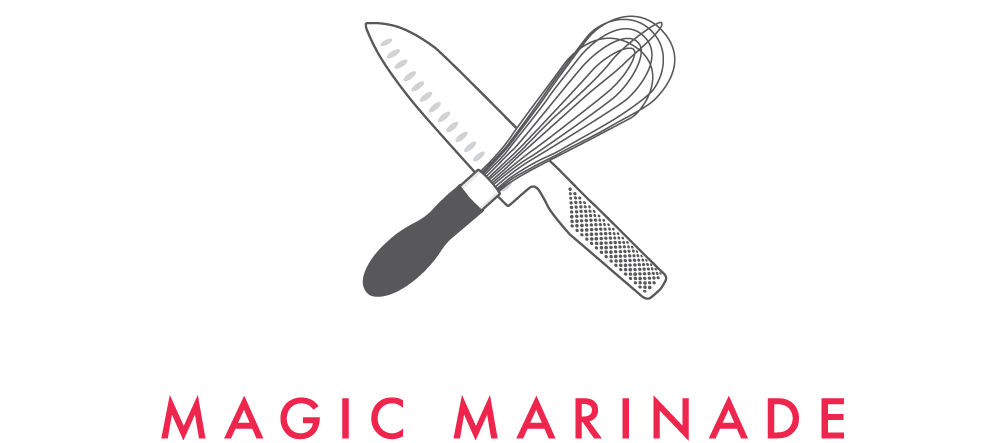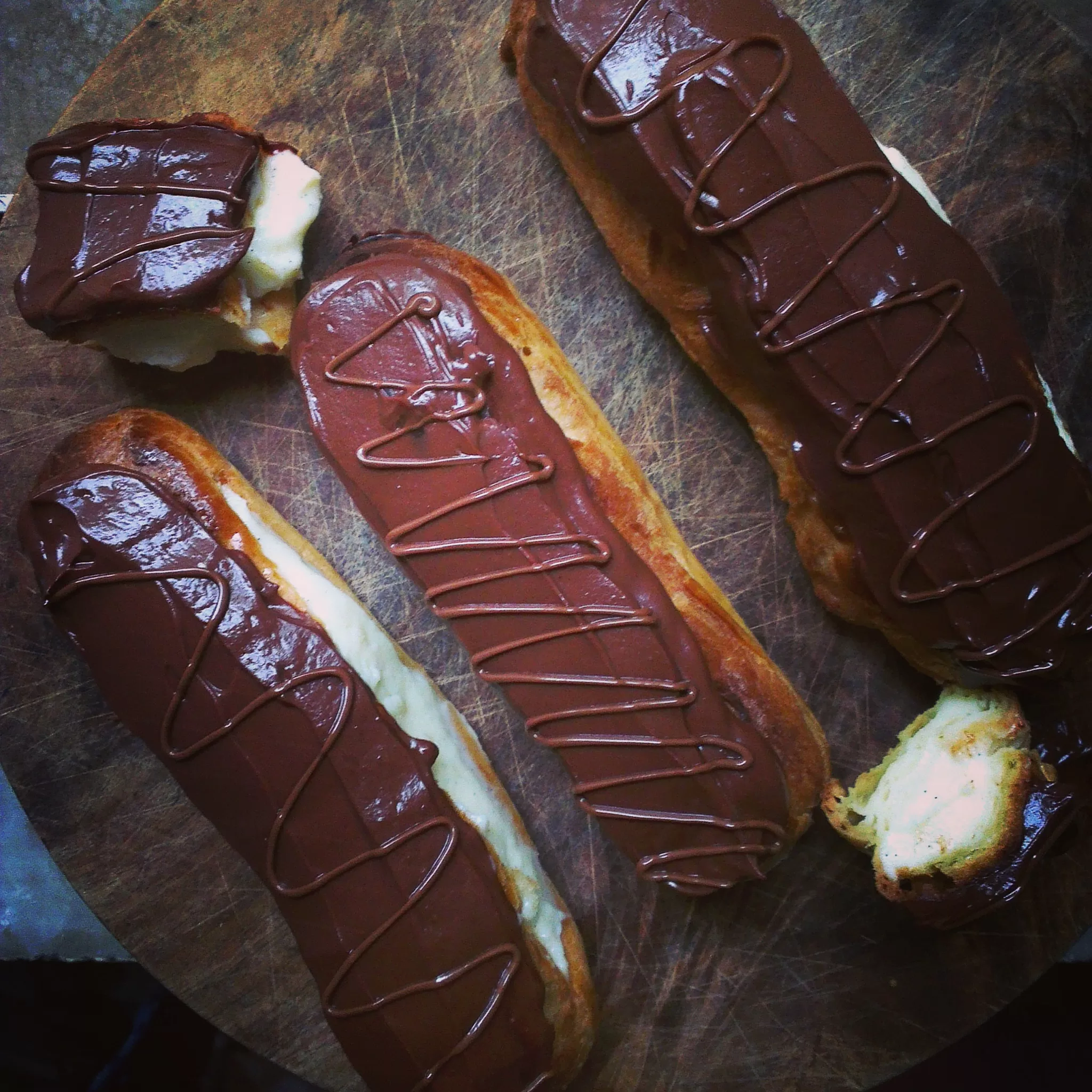It has been a little over a year since my first foray into the world of choux pastry. I always wanted to give making my own éclairs a shot, but it finally took a strange series of events that led me to actually attempting it. I made a simpler sort of lemon cremé patissiere last year, but this time around I wanted to give the real thing a shot. Working out the perfect recipe wasn’t as easy as I thought, since most recipes out there use cornflour as a thickening agent. There really isn’t much wrong with using cornflour, but I’ve always had this feeling that it lends a chalky tastelessness to anything it is put into. Of course, this might be something entirely in my imagination, but I suspected this could be pulled off with just eggs, milk and regular flour.
From what I remember of éclairs from my college days, most of them were filled with sweetened whipped cream (possibly a simpler workaround to making industrial quantities of cremé patissiere) and had a thin layer of chocolate that looked like it was painted on, though it was most probably dipped in it. The texture of the choux was almost always perfect with the right amount of bite enclosing its cream-filled void.
It took me a while to perfect a replication of that same texture. Steam is the main component of the baking process of choux that inflates it from an inch thin batter-dough to a billowy light pastry cloud of goodness, but it is also steam, when not managed properly, that contributes to making the pastry soft and limp. If the steam doesn’t escape (some go so far as to recommend pulling the choux out two thirds into the bake and stabbing it in places to release the steam before returning it to the oven), the insides of the pastry can be quite doughy and soft. I found that piping the choux out on a buttered sheet of foil (instead of parchment or a tray) helped cook the shell of the choux out more evenly. I did also stab a knitting needle (I keep one in the kitchen to test cakes with) into the body of the choux while it baked in the oven to let out some steam.
There is a sense of magic to the whole process (and it is a very method and process oriented recipe), where butter, water, flour and eggs transform into this perfect enclosure for assorted creamy goodness. Most recipes tend to be forgiving, allowing you to do things your own way, but the making of choux is one that rewards you for following all the steps, in order, without skipping any. The bonus here is that it isn’t a matter of great skill and judgement, like puff and shortcrust pastry, where one has to constantly and carefully assess the way the butter blends (or doesn’t blend) into the flour for optimum results. If you follow the steps, there is very little chance that you’d go wrong, or would end up with a faulty pastry. The only thing you need to keep an eye out for is the gloss of the final pastry dough, which takes on an unmissable sheen, and holds its shape when spooned or scooped.

A cross section (with teethmarks) of the finished, filled éclair. I like using real vanilla beans for the cremé patissiere because it leaves a pretty vanilla-black stippling through the body of the cream.
Three things make up the aroma of a chocolate éclair done right. The scent of chocolate (which dominates), the freshly baked warm aroma of the choux, and the vanilla in the cremé patissiere. You could use vanilla extract, but I’d recommend using a whole vanilla bean instead. It’s a small detail, but the tiny dots of vanilla caviar contribute to a slightly more aesthetic cremé patissiere. The aroma and flavour of vanilla is also stronger when its from the bean directly.
The quality of chocolate also matters a lot (as always), and I like my chocolate dark and not too sweet, so I used a Lindt 70% dark chocolate for the ganache. There’s a chance some might find this too bitter, so I initially planned to lace the éclairs with thinly piped waves of milk chocolate (and white chocolate). Standard store variety milk chocolate (Dairy Milk Silk, for example) doesn’t do too well when heated though, and my first attempt at making a butter-milk chocolate blend failed, with the chocolate seizing and splitting. That’s when the idea of using Nutella struck me. Nutella has just the right amount of chocolate-hazelnut sweetness to balance out the rich bitter cocoa of the chocolate, before the (not very sweet) cremé patissiere hits the palette.
In spite of the fact that I have a massive sweet tooth, I tend to make all my sweets and desserts with the bare minimum amount of sugar they’d need. I’ve found that a true celebration of sweetness happens in the moderate use of it, as opposed to saturating it with sugar. It allows other flavours (like the chocolate in this éclair, or the carrot in a carrot halwa or cake) to sing, making for a more nuanced and sophisticated composition of flavours.
Don’t let the number of subdivisions in this recipe scare you. Amongst all the things I’ve made, chocolate éclairs are actually amongst the easiest and quickest to make. It won’t take more than twenty minutes to make the choux batter-dough (since things move pretty quickly between steps, and there is practically no waiting time) and cremé patissiere (I’d advise you to make the cremé patissiere earlier and chill it in the fridge, since it always works and handles better when it’s cool). You can even prep the ganache while the choux bakes, which means you can have your éclairs ready in just around an hour.
I know many who are quite fond of these delicious phallic treats, and I’d thoroughly encourage you to make your own— not just for the pleasure of creating something you love with your own hands, but also because of how simple it actually is. We’ve seen and baked enough cakes, cupcakes and pies; I think its high time the humble chocolate éclair claimed itself as a simple home-baked treat, as opposed to something you’d only always see and buy from a glass case in a pastry shop.
The Recipe
Ingredients
For the choux pastry
1½ cup water
100g butter
175g maida
30g sugar
4 eggs
¼tsp salt
Yields around 20 10cm éclairs or 12 15cm ones.
For the Cremé Patissiere
3 yolks & 1 egg
110g+1tbsp sugar
500ml milk
50g Maida
Vanilla (1 pod or teaspoon)
For the ganache
100g pure cream
80g dark chocolate, chopped
15g butter
3tbsp honey
1tbsp Old Monk Rum
1tbsp Nutella
Method
For the Cremé Patissiere:
- Whisk the whole egg, yolks and sugar in a glass, ceramic or metal bowl till very pale.
Whisk the maida in slowly. - In a heavy bottomed saucepan, bring the milk and vanilla to a boil. Using a vanilla pod (pod and all, contents scraped out) is ideal, or you could use a teaspoon or two of vanilla extract (depending on its strength).
- Pour a small amount of the hot milk over the yolk-sugar-flour mix and while whisking vigorously. Keep adding milk till all of it is incorporated.
- Pour it back into the saucepan and whisk over a high heat for a few minutes (it takes anything between two to four) till the cremé patisserie thickens. Let this cool just a bit and transfer it into piping bags and put them in the fridge to chill.
For the Choux Pastry:
- In a saucepan with a heavy bottom, add the water, butter and sugar and bring to a boil and then take off the heat.
- Sift the flour and add it all at once into the water and mix with a wooden spoon. The dough will suddenly come together, so you might want to shift to a whisk if that’s more comfortable.
- Put it back on the heat and cook for a while till the batter starts to come off the sides of the pan (it’ll come together well).
- Let this cool; you could keep whisking the steam out till you can handle the saucepan without hurting yourself. At this point, preheat your oven to 200ºC.
- Add one egg and whisk till evenly incorporated. Add the second egg only after the first one is completely incorporated. Add the remaining eggs the same way. Whisk till absolutely even. The batter should be thick and glossy.
- Pipe onto a baking sheet or piece of foil buttered and dusted with flour. I marked out 10cm divisions by folding creases into the paper. Pipe out long, even lengths of dough.
- Brush the dough with an egg wash. Using a fork, rake the surfaces of the dough gently.
- Bake for 35 minutes (or until the pastry turns a shade of dark golden brown) and open the oven door just a crack to let the steam out in the last ten minutes of the bake.
For the ganache:
- While the pastry bakes, heat the cream in a heavy bottomed saucepan till it starts to bubble at the edges. Don’t let it burn.
- Add the chocolates and turn off the heat– mix briskly till all of it dissolves and leaves no lumps.
- Mix the butter, honey and brandy/rum in till evenly incorporated.
- Set aside for a bit.
- Fill a small piping bag with the Nutella.
Assembly:
- Carefully slit the sides of the baked pastry and make room for the cremé patissiere.
- Slip the tip of the piping bag into this slit and pipe in a generous amount of the cremé patissiere.
- Spoon some ganache evenly on top of the éclairs and smooth it out along its length.
- Cut the very tip of the piping bag with the Nutella (you want a 1-2mm aperture) and pipe a thin zigzag onto the chocolate (like in the pictures above, but feel free to experiment with this; I wasn’t very neat or precise about this, but I might be the next time I do this).
- Let this chill in the fridge, though you can also serve it immediately. You’d most probably want to eat one right away anyway.








